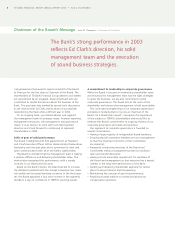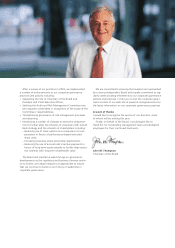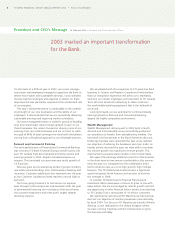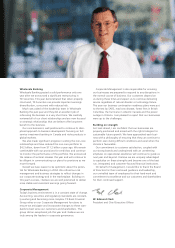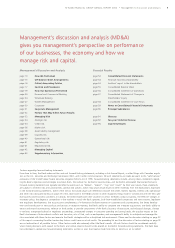TD Bank 2003 Annual Report Download - page 16
Download and view the complete annual report
Please find page 16 of the 2003 TD Bank annual report below. You can navigate through the pages in the report by either clicking on the pages listed below, or by using the keyword search tool below to find specific information within the annual report.
TD BANK FINANCIAL GROUP ANNUAL REPORT 2003 • Management’s Discussion and Analysis14
Efficiency ratio
The efficiency ratio measures the efficiency of operations.
It’s calculated by taking expenses as a percentage of
total revenue. The lower the percentage, the greater
the efficiency.
See supplementary information page 48, table 7
On an operating cash basis, the Bank’s overall efficiency ratio
weakened to 73.9% from 64.9% in 2002 and 64.5% in
2001. The Bank’s consolidated efficiency ratio is impacted by
shifts in its business mix. The efficiency ratio is viewed as a
more relevant measure for Personal and Commercial Banking,
which had an efficiency ratio of 58.8% this year compared
with 60.7% in 2002 and 61.5% in 2001. During fiscal 2003,
the method used to calculate the efficiency ratio for Personal
and Commercial Banking was simplified to no longer exclude
the funding costs for the acquisition of Canada Trust. On a
reported basis, the Bank’s overall efficiency ratio weakened to
83.3% from 75.8% in 2002 and 79.8% in 2001.
Taxes
The Bank carries on many businesses in many different
locations with differing outcomes, resulting in a mix of tax
payments and tax recoveries. The Bank continues to pay
significant amounts of tax to governments across Canada.
Supplementary table 8 on page 49 lists the various taxes the
Bank has paid over the past five years.
Note 15 of the Bank’s Consolidated Financial Statements
sets out the key tax measurements under generally accepted
accounting principles.
The Bank's home jurisdiction, Ontario, has announced that
it will be increasing corporate income taxes and stopping the
planned elimination of capital taxes. As a result, the expected
rate of Canadian taxes in the future will be higher than previ-
ously thought although still lower than in 2003. The federal
government has promised the phased elimination of its prin-
cipal capital tax.
In 2003, the write down of some businesses added to
the net future tax asset of the Bank. This was in addition to
the substantial increase caused by the large sectoral loan
provisions recorded in 2002. The effective use of these assets
is dependent upon a continued return to ordinary levels of
profitability, particularly in the Bank’s U.S. operations. This
increase was offset to a significant extent by the usage of a
portion of the sectoral provisions against specific loans as
well as the release of provisions for both sectoral and general
loan losses.
Balance sheet
See Consolidated Balance Sheet page 55
Total assets were $274 billion at the end of the year, $4 bil-
lion or 2% lower than as at October 31, 2002. A decline in
investment securities activity resulted in a $4 billion decrease
and business and government loans decreased by $11 billion
as compared with October 31, 2002. However, securities
purchased under resale agreements increased by $4 billion to
$17 billion due to increased securities volumes. Also, as com-
pared with last year, personal loans, including securitizations,
increased by $6 billion to reach $49 billion. At the end of
the year, residential mortgages, including securitizations,
increased by $5 billion to reach $72 billion as compared with
last year. Bank-originated securitized assets not included on
the balance sheet amounted to $18 billion compared with
$15 billion at October 31, 2002. Wholesale deposits
decreased by $14 billion as compared with October 31, 2002.
However, personal non-term deposits increased by $2 billion
to $53 billion and personal term deposits increased by
$3 billion to $53 billion compared with October 31, 2002.
Total assets were $278 billion at October 31, 2002, $10 bil-
lion or 3% lower than as at October 31, 2001. Lower volumes
from trading securities contributed $13 billion to the decrease
in total assets with securities purchased under resale agree-
ments representing $7 billion of the decrease. Personal loans,
including securitizations, increased by $2 billion, primarily
attributable to a solid performance in real estate secured lines
of credit in Personal and Commercial Banking. At the end of
fiscal 2002, residential mortgages, including securitizations,
increased by $1 billion from 2001 to $67 billion. As at
October 31, 2002, wholesale deposits decreased by $11 bil-
lion and securities under repurchase agreements decreased
by $6 billion as compared with October 31, 2001. Personal
non-term deposits grew by $4 billion from October 31, 2001
to reach $51 billion at the end of fiscal 2002, with Personal
and Commercial Banking accounting for the majority of
this increase. Personal term deposits remained unchanged
at $50 billion compared with 2001.
The Bank also enters into structured transactions on
behalf of clients which result in assets recorded on the Bank’s
Consolidated Balance Sheet for which market risk has been
transferred to third parties via total return swaps. As at
October 31, 2003, assets under such arrangements amount-
ed to $13 billion compared with $11 billion in 2002 and
$10 billion in 2001. The Bank also acquires market risk on
certain assets via total return swaps, without acquiring the
cash instruments directly. Assets under such arrangements
amounted to $6 billion as at October 31, 2003 compared
with $6 billion in 2002 and $6 billion in 2001. Market risk
for all such positions is tracked and monitored, and regulatory
market risk capital is required. The assets sold under these
arrangements are discussed in the other financial transactions
section on page 15 are included in this amount. See Note 18
of the Bank’s Consolidated Financial Statements for more
details of derivative contracts.
Efficiency ratio
(percent)
Efficiency ratio –
reported basis
Efficiency ratio –
operating cash basis
100 %
0
60
80
40
20
0301 02


